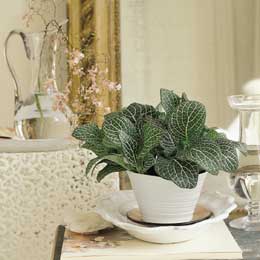Neutral and natural
Designing your indoor space can be taken to new heights when you include carefully chosen plants. Against a neutral colour scheme, brightly coloured plants can add welcome highlights, while white-flowering plants can enhance the sense of minimalism and calm.
Using plants to achieve a unified interior design
Plan ahead – Decide early on in your room planning whether you are looking for plants that will echo the neutral feel of the interior space or those which will provide bolder focal points
Matt-textured pots – These look far more restrained than those with a gloss and will better suit your natural approach to interior design
Consider the foliage – Think about the plant’s foliage as well as its flowers. The contrast between the two can provide subtle areas of colour interest in the room.
Plants and flowers to grow
- Stephanotis – Stephanotis Floribunda or “Madagascar Jasmine” is one of the most coveted houseplants because of its intensely powerful, sweet smelling blossoms. But it also works well within a neutral colour scheme because of its smooth dark green leaves and white flowers which are tubular as buds, opening into five-pointed stars.
- Gardenia – Most gardenias grow into a round shape, with glossy leaves and white, fragrant flowers, meaning your interior design scheme can benefit from a year-round dark green focal point which blossoms with brilliant highlights from mid-spring into summer.
- Jasmine – Believed to have originated in the Himalayas of western China, Jasmines have oval, shiny leaves and tubular, waxy-white flowers. This delicate combination works well in neutral settings, with the added bonus of that famous delicious scent.
- Fittonia – Native to South America, the Fittonia (or Nerve Plant or Mosaic Plant) has beautiful, deep-green leaves with distinctive vein patterns of white, pink, or red, making it ideal for those neutral interior spaces which need elements of natural drama.
- Peperomia – A compact houseplant, the Peperomia-caperata has short stems covered in heart-shaped green leaves with deep ridges and often blushes subtle of red. In the summer and autumn it can produce slender flower spikes. Peperomia is ideal for providing isolated pockets of interest.
Tips
Do consider the space you are working with. Remember that the larger the room, the bigger and more numerous the plants can be. Equally, a single plant can look somewhat lost in a large empty space. Several flowering plants in a basket or arranged in small pots on the same table can serve as a beautifully colorful accent to a more understated room. In a small room, large plants are oppressive and take up valuable space. Instead, choose mid-size or small specimens with large delicate leaves. Also, place plants where they are going to be visible and bear in mind that for real impact they often look best against simple neutral backgrounds.
References
http://livinghouseplants.com/stephanotis.htm
http://www.garden.org/plantguide/?q=show&id=2135
http://www.theflowerexpert.com/content/giftflowers/flowersandfragrances/jasmine
http://www.guide-to-houseplants.com/nerve-plant.html
http://www.guide-to-houseplants.com/peperomia-caperata.html
http://www.gardeningknowhow.com/indoor/interior-decorating-with-houseplants.htm



